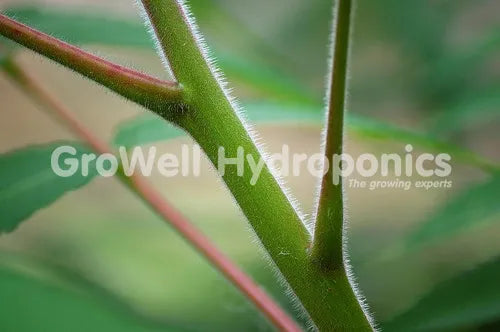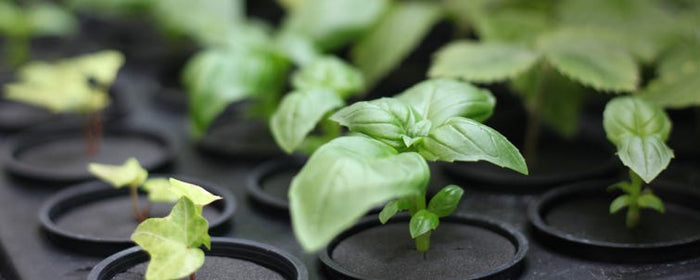Why Plants LOVE Silicon
Ever heard of liquid silicon? Plants will survive without it, but they’ll be much hardier with it!
When absorbed by plants, it:
- Strengthens roots, stems, leaves & branches
- Improves disease & pest resistance
- Builds heat, cold, humidity & wind tolerance
- Prevents nutrient deficiencies
- Enhances growth
Use it, and you'll get bigger, stronger crops that grow and yield better. Here’s the science behind silicon:
What's Silicon?
It’s a natural element that helps create everything in the universe.
You can find it in sand (silicate dioxide).
It’s also in sheet silicates, which form over 90% of the earth’s crust! Sheet silicates are made of silicon, oxygen, metals & minerals.
Silicon is extracted from sheet silicates as a monosilic acid, which makes it available to plants.

How It Works
Silicon mostly strengthens the physical structure of your plants.
It thickens cell walls and the bonds between cells.
When plants take in silicon, they’ve got about 24 hours to decide where to put it (between or in cell walls). Silicon deposits then set in place - like cement! As a result, cells become thicker and stronger.
All areas of your plant are affected – roots, stems, branches, leaves.

Increases Disease & Pest Resistance
Silicon bolsters cell walls and the bonds between them. This makes it tougher for pests and diseases to get a foothold & spread.
On top of this, plants are able to create a thick outer coating that bugs won’t break through (even aphids & spider mites). Diseases won’t fare much better - that includes powdery mildew, Pythium (root rot) & botrytis (bud rot).
Best of all, plants are pretty clever when it comes to silicon. They can direct freshly absorbed supplies to stressed or vulnerable areas when under attack! That's an intelligent natural defense system for you! It's one of the reasons why you need to dose often.
Prevents Wind Damage
Over time, stems strengthen to the point bulky plants can stay upright through challenging conditions. That’s without support devices like yo-yo’s & netting (still use them).
With a structure like that, rushes of air are less of a risk. Plants are way less likely to snap or topple over when hit by gushes of air. Instead, they’ll bend and flex with the movement of air.

Supports a Bigger Yield
In flowering, plants can support heavier fruits and flowers, encouraging plants to yield more.

Enhances Growth & Development
Silicon helps build a bigger, stronger Phloem and Xylem in the stem structure. This means plants can translocate more nutrients and water, at a quicker pace.
This, in turn, means plants absorb more elements that are tough to uptake (e.g. calcium). As a result, plants grow bigger and faster.

Boosts Heat, Humidity & Stress Resistance
Since plants are working more efficiently, they can function better under heat, humidity & other extremes (like lack of water!).
For example, at temperatures over 30oC, plants stop turning food into energy. They just don’t have the water they need for it - too much is lost through transpiration (sweating).
With silicon strengthening cell walls, water can be moved at higher temperatures and the rate of transpiration drops. This means plants can continue turning food into energy.
![]()
Strengthens Cuttings & Seedlings
Toughen cuttings and seedlings from day 1 by applying silicon as a foliar spray.
Doing this lays the foundations for future growth!

Increases Photosynthesis
All of those rich, green, wide spanning leaves that silicon helps plants produce are exposed to sunlight, CO2 and water. That means plants can photosynthesise more.
That’s where plants use CO2, H2O and sunlight to make sugars.

Prevents Nutrient Deficiencies & Toxicity
Silicon encourages plants to absorb more:
- zinc (for growth & photosynthesis)
- calcium (for growth, enzyme activity metabolism & uptake)
- nitrogen in soil (for veg growth & most plant functions)
 It also balances the uptake of phosphorus, to prevent toxicity.
It also balances the uptake of phosphorus, to prevent toxicity.
Because plants absorb more zinc, calcium and nitrogen, they absorb less of the nutrients they don’t need much of - like aluminium, manganese & iron. This stops unhealthy & excessive nutrient consumption.
How to Add Silicon
In soil, hydro & coco, you can boost silicon levels with SHOGUN Silicon.
These provide a soluble form of silicon (potassium silicate), which is readily available to plants. As a bonus, it’s a good source of potassium, which we all know is vital in flowering.
Base feed
1) Start with dechlorinated water - there are 3 ways to dechlorinate:
- Let your tap water stand for 24 hours before mixing your nutrients
- Add a few drops of Ecothrive Neutralise
- Use RO water
2) Do not add any nutrients while filling your tank with water
3) Consider adding a water pump to keep your water moving and oxygenated
4) Ensure the pH of your water is no higher than 7.0 - if it's below 7.0 you don't need to adjust yet as the silicon will increase your pH
5) Add your silicon
6) Adjust your pH back to 7.0 - only adjust your pH in one direction (up or down) - and do it gradually to make sure you don't over-adjust.
7) Once at pH 7, introduce your nutrients
8) Adjust pH to the level that's optimum for your plants
You do not want to add silicon after your base nutrients - if you do, your solution will turn white and cloudy. Soon after, you'll see white crystalised structures forming at the bottom of your tank. The crystalised sediment is nutrients that are now unavailable to your plants, a reaction caused by silicon's high pH. This sediment can also clog up pumps and pipes.
Remember, plants only have 24 hours after absorption to deposit silicon. This means, a little and often dosing strategy is best.
To really see the benefits of silicon, you need to apply on a regular basis, throughout your grow. We recommend applying it as a root feed, with an occasional foliar spray when needed.
Propagation:
Propagating plants are still very delicate. Apply silicon as a foliar spray
In Soil:
Soil already contains some silicon – about half the amount plants can use.
To get the best out of plants, add some more as a foliar spray.
In Hydro & Coco:
Unless you add it yourself, plants won’t get any silicon. You can add it as a root feed or foliar spray.
Foliar Spray
Foliar spray at at recommended dilution. Make sure your pH is 5 - 7 or you could physically harm the plant.




